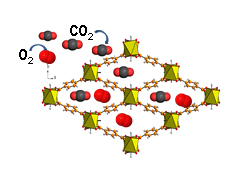Renewable energies
The production of clean energy is one of the main challenges of our society today. Porous solids can provide many answers and even revolutionize the field of energy conversion and storage. Respore's teams have joined forces to address the scientific challenges that remain before the development of useful materials that can be used on a large scale.
Controlled porous architectures can be used, depending on targeted applications, as passive or active elements. By modulating their electronic, optical or mechanical properties, it is possible to build bi-functional architectures within the same material and to create active and intelligent systems: 3D electrodes, more efficient photovoltaic cells, etc.
For example, use the selectivity of porous membranes to capture CO2 while generating electricity. But the advancement would be even greater by using these membranes as a host of sensors, additives or self-repairing molecules that would allow to monitor the health status of the batteries and thus to extend their durability.
New generations of batteries could also emerge using porous solids to manufacture membranes with exacerbated conductivity and lift the current technological locks related to lithium-based batteries.
In addition, research on porous solids paves the way for more efficient systems for the storage of biosourced strategic gases such as methane or dihydrogen (H2), carbon dioxide (CO2) capture, or heat transfer (solar, thermal, heat pumps ...).
For example, dihydrogen (H2), commonly known as hydrogen, can be converted into electricity, heat or motive power. Producing H2 on a large scale from biomass or water dissociation would make it a real alternative energy source to hydrocarbons. This production could be carried out from processes using new (photo) porous catalysts to achieve superior and durable performance.
 Diagram of a CO2 capture process generating electricity via the use of a porous solid (MOF) and the synergy between electrochemical and chemical reactions
Diagram of a CO2 capture process generating electricity via the use of a porous solid (MOF) and the synergy between electrochemical and chemical reactions